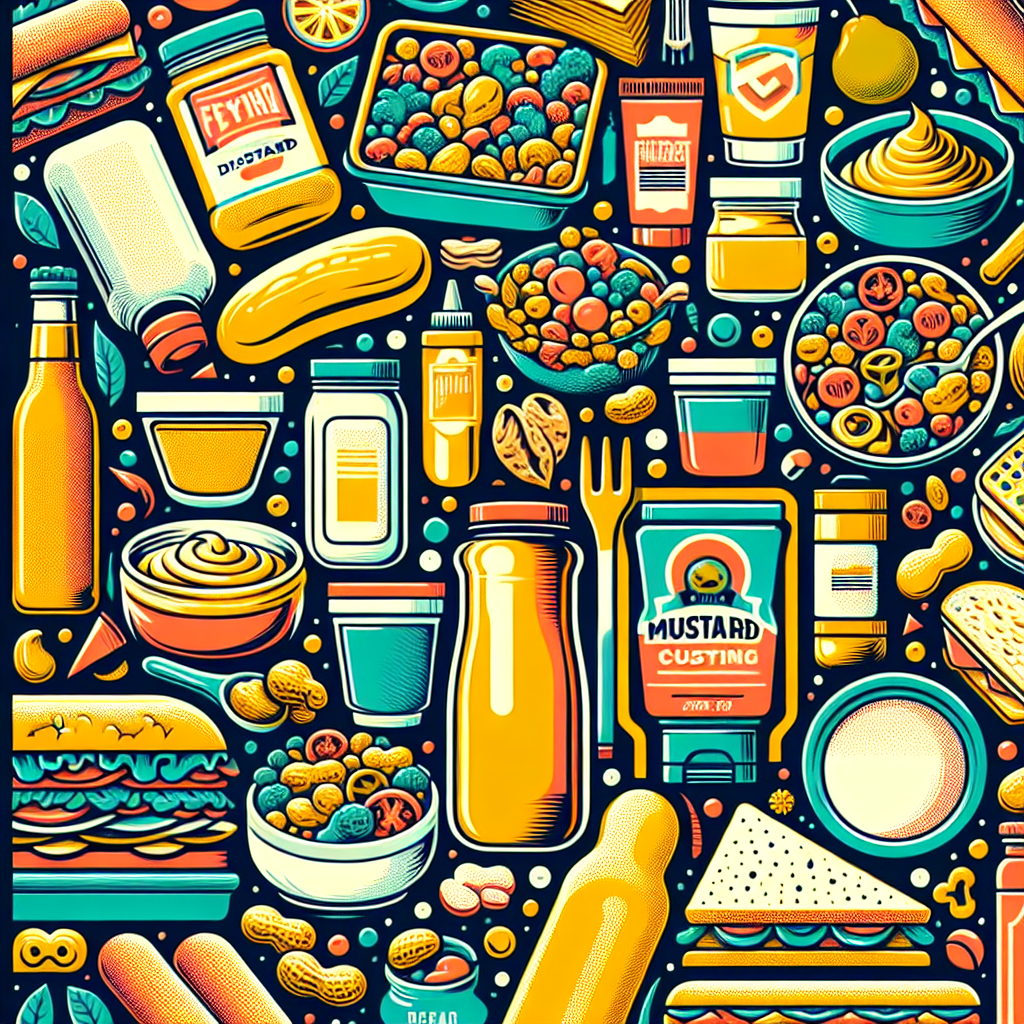The Food Standards Agency (FSA) is warning people with peanut allergies to avoid foods with mustard because they might have peanuts in them. Mustard ingredients like mustard powder or flour are often in dips, sauces, salads, and pre-packaged sandwiches. The FSA is looking into how many products are affected, and about 50 items have already been recalled. Parents of kids with peanut allergies should check food labels and ask at restaurants about foods with mustard.
Some products, like Dominos dips, SPAR sandwich fillers and salads, and Harvester BBQ sauce, are being taken off the shelves because they might have peanuts in them. The mustard ingredients with peanuts came from GT Agro Industries in India, and FGS Ingredients supplied them to UK food makers. Because peanut allergies can be very serious, the FSA is being careful to keep people with allergies safe. Rebecca Sudworth, FSA’s director of food policy, says it’s important to avoid foods with mustard until they figure out which ones are affected.
Mustard is an allergen, so it should be clearly marked on food packages if it’s in there. Labels like “may contain” are used when there’s a chance that food might have mustard in it by accident. Peanuts are a common allergen, affecting about 1 in 50 kids, so they’re not allowed in many schools. Allergic reactions to peanuts happen when the body reacts to peanut proteins and can cause different symptoms like dizziness, skin issues, swelling, breathing problems, nausea, tummy pain, and diarrhea.
The FSA will keep updating people as they find out more about which products are affected. If you have a peanut allergy, it’s important to be careful and avoid foods with mustard until they give the all-clear. Knowing the risks of food allergies and checking labels and asking about ingredients can help you stay safe if you have allergies. People with allergies should be aware of possible cross-contamination of allergens in foods and take steps to protect their health.
Original news source: Peanut allergy warning over dips and sandwiches (BBC)
🎧 Listen:
Slow
Normal
Fast
📖 Vocabulary:
| 1 | allergen | Something that can cause an allergic reaction |
| 2 | contamination | When something is made dirty or harmful by another substance |
| 3 | symptoms | Signs or feelings that show you might be sick |
| 4 | recall | When a product is taken back because it’s not safe |
| 5 | ingredient | A part of a food or recipe |
| 6 | allergen | Something that can cause an allergic reaction |
| 7 | dizziness | Feeling like the room is spinning or you’re going to fall |
| 8 | nausea | Feeling sick to your stomach |
| 9 | diarrhea | When you have loose or watery bowel movements |
| 10 | swelling | When a part of your body gets bigger because of injury or illness |
| 11 | cross-contamination | When one food gets mixed with another by accident |
| 12 | policy | A set of rules or guidelines |
| 13 | proteins | Important parts of food that help build and repair the body |
| 14 | avoid | To stay away from something |
| 15 | pre-packaged | Already prepared and wrapped for sale |
Group or Classroom Activities
Warm-up Activities:
– **Word Association**
Instructions: In pairs, take turns saying a word related to the article. The next person has to say a word related to the previous one. For example, if one person says “mustard,” the next person could say “allergies.” Keep going back and forth, trying to make as many connections as possible.
– **Headline Creation**
Instructions: In small groups, create a catchy headline for an article about the FSA warning regarding peanuts in foods with mustard. Think about using keywords from the article and making the headline informative and attention-grabbing. Share your headlines with the class and discuss which one is the most effective.
– **Pros and Cons**
Instructions: Working individually, create a list of pros and cons related to the FSA’s warning for people with peanut allergies to avoid foods with mustard. Think about the impact on people’s health, food safety measures, and public awareness. After making your lists, pair up with a classmate and discuss your points, trying to persuade each other of your perspective.
– **Vocabulary Pictionary**
Instructions: Choose key vocabulary words from the article (e.g., allergies, mustard, FSA) and write them on separate pieces of paper. In pairs, take turns picking a word and drawing it while your partner guesses. Try to convey the meaning of the word without using any letters or numbers. This will help reinforce the vocabulary related to the article.
– **News Summary**
Instructions: In groups of three, take turns summarizing different parts of the article about the FSA’s warning. Each person should focus on summarizing a specific section, such as the cause of the warning, the affected products, or the importance of checking food labels. After everyone has shared their summaries, discuss as a group to create a comprehensive overview of the article.
🤔 Comprehension Questions:
1. Why is the Food Standards Agency warning people with peanut allergies to avoid foods with mustard?
2. What are some examples of foods that might have mustard ingredients with peanuts in them?
3. Where did the mustard ingredients with peanuts come from?
4. Why is it important for parents of kids with peanut allergies to check food labels and ask about foods with mustard?
5. How are allergens like mustard usually marked on food packages?
6. What are some symptoms of allergic reactions to peanuts?
7. Why are peanuts not allowed in many schools?
8. What advice does the Food Standards Agency give to people with peanut allergies regarding foods with mustard?
Go to answers ⇩
🎧✍️ Listen and Fill in the Gaps:
The Food Standards Agency (FSA) is warning people with (1)______ allergies to (2)______ foods with mustard because they might have (3)______ in them. Mustard ingredients like mustard powder or (4)______ are often in dips, sauces, salads, and pre-packaged sandwiches. The FSA is looking into how many products are affected, and about 50 items have already been recalled. Parents of kids with peanut allergies should check food labels and ask at restaurants about foods with mustard.
Some products, like Dominos dips, SPAR sandwich fillers and salads, and Harvester BBQ sauce, are being (5)______ off the shelves because they might have peanuts in them. The mustard (6)______ with peanuts came from GT Agro Industries in India, and FGS Ingredients (7)______ them to UK food makers. Because peanut allergies can be very serious, the FSA is being careful to keep people with allergies safe. Rebecca (8)______, FSA’s director of food policy, says it’s important to avoid foods with mustard until they figure out which ones are affected.
(9)______ is an allergen, so it should be clearly marked on food packages if it’s in there. Labels like “may contain” are used when there’s a chance that food might have mustard in it by accident. Peanuts are a common allergen, affecting about 1 in 50 kids, so they’re not allowed in many schools. Allergic (10)______ to peanuts happen when the body reacts to peanut proteins and can cause (11)______ symptoms like dizziness, skin issues, (12)______, breathing problems, nausea, tummy pain, and diarrhea.
The FSA will keep updating people as they find out more about which products are affected. If you have a peanut (13)______, it’s important to be careful and avoid (14)______ with mustard until they give the all-clear. Knowing the risks of food (15)______ and checking labels and asking about ingredients can help you stay safe if you have allergies. People with allergies should be aware of possible cross-contamination of (16)______ in foods and take steps to protect their health.
Go to answers ⇩
💬 Discussion Questions:
Students can ask a partner these questions, or discuss them as a group.
1. What is a food allergen?
2. How would you feel if you had a peanut allergy and found out that foods with mustard might have peanuts in them?
3. Do you like mustard on your food? Why or why not?
4. Do you think it’s important for food packages to clearly label allergens like mustard?
5. How would you react if you found out a food you ate had an allergen that you’re allergic to?
6. What steps do you think restaurants should take to ensure they don’t serve foods with allergens?
7. Why do you think it’s important for parents of kids with allergies to check food labels?
8. Have you ever had a food allergy scare or reaction? What happened?
9. Do you think the FSA is handling the situation well by recalling products with potential allergens?
10. How can people with food allergies protect themselves when eating out at restaurants?
11. Why do you think it’s important for food makers to be transparent about the ingredients they use?
12. What do you think are the most common food allergens?
13. How do you think the FSA could improve their communication about food allergen recalls?
14. Do you know anyone with a food allergy? How do they manage it?
15. Why do you think it’s important for schools to have strict rules about allergens like peanuts?
Individual Activities
📖💭 Vocabulary Meanings:
Match each word to its meaning.
Words:
1. allergen
2. contamination
3. symptoms
4. recall
5. ingredient
6. allergen
7. dizziness
8. nausea
9. diarrhea
10. swelling
11. cross-contamination
12. policy
13. proteins
14. avoid
15. pre-packaged
Meanings:
(A) When a product is taken back because it’s not safe
(B) When a part of your body gets bigger because of injury or illness
(C) Important parts of food that help build and repair the body
(D) Signs or feelings that show you might be sick
(E) When something is made dirty or harmful by another substance
(F) When one food gets mixed with another by accident
(G) Already prepared and wrapped for sale
(H) A part of a food or recipe
(I) Feeling like the room is spinning or you’re going to fall
(J) Something that can cause an allergic reaction
(K) A set of rules or guidelines
(L) Feeling sick to your stomach
(M) To stay away from something
(N) When you have loose or watery bowel movements
(O) Something that can cause an allergic reaction
Go to answers ⇩
🔡 Multiple Choice Questions:
1. What is the main reason the FSA is warning people with peanut allergies to avoid foods with mustard?
(a) Mustard is a common allergen
(b) Mustard is not good for health
(c) Mustard ingredients might have peanuts in them
(d) Mustard is too spicy for some people
2. Where did the mustard ingredients with peanuts come from?
(a) FSA in the UK
(b) GT Agro Industries in India
(c) Dominos in the US
(d) Harvester in Australia
3. What should parents of kids with peanut allergies do according to the article?
(a) Avoid all foods with mustard
(b) Check food labels and ask at restaurants about foods with mustard
(c) Stop eating mustard completely
(d) Ignore the warning from the FSA
4. Why are some products like Dominos dips and SPAR sandwich fillers being taken off the shelves?
(a) They expired
(b) They are too spicy
(c) They are not popular
(d) They might have peanuts in them
5. What is one common symptom of allergic reactions to peanuts mentioned in the article?
(a) Breathing problems
(b) Hiccups
(c) Yawning
(d) Sneezing
6. How are allergens like mustard usually marked on food packages?
(a) With invisible ink
(b) In a tiny font
(c) Clearly
(d) Nowhere on the package
7. What is one way to stay safe if you have food allergies according to the article?
(a) Checking labels and asking about ingredients
(b) Ignoring food labels
(c) Eating everything
(d) Avoiding all foods with allergens
8. Why is it important for people with peanut allergies to be careful and avoid foods with mustard?
(a) Because mustard is too spicy
(b) Because mustard is not healthy
(c) Because mustard is not tasty
(d) Until the FSA gives the all-clear
Go to answers ⇩
🕵️ True or False Questions:
1. Around 30 products have been recalled so far as the FSA investigates how many items are safe.
2. Mustard ingredients like mustard paste or meal can be found in dips, sauces, salads, and pre-packaged sandwiches.
3. It’s not important for individuals with peanut allergies to avoid foods with mustard until the FSA confirms which products are safe.
4. The Food Standards Agency is warning people with peanut allergies to avoid foods with mustard due to potential peanut contamination.
5. Labels should not clearly indicate if mustard is present in food due to it being an allergen.
6. The peanuts in mustard ingredients originated from GT Agro Industries in India and were supplied to UK food makers by FGS Ingredients.
7. Peanut allergies can be severe, so the FSA is taking precautions to ensure the safety of those with allergies.
8. Some products like Dominos dips, SPAR sandwich fillers, and Harvester BBQ sauce are being removed from shelves due to potential peanut presence.
Go to answers ⇩
📝 Write a Summary:
Write a summary of this news article in two sentences.
Check your writing now with the best free AI for English writing!
Writing Questions:
Answer the following questions. Write as much as you can for each answer.
Check your answers with our free English writing assistant!
1. Why is the Food Standards Agency warning people with peanut allergies to avoid foods with mustard?
2. What are some examples of products that have been recalled because they might contain peanuts due to mustard ingredients?
3. Why is it important for parents of kids with peanut allergies to check food labels and ask about foods with mustard?
4. How are food packages marked to indicate the presence of allergens like mustard?
5. What are some symptoms of allergic reactions to peanuts mentioned in the article?
✅ Answers
🤔✅ Comprehension Question Answers:
1. Why is the Food Standards Agency warning people with peanut allergies to avoid foods with mustard?
The Food Standards Agency is warning people with peanut allergies to avoid foods with mustard because some mustard ingredients might have peanuts in them, which can trigger allergic reactions in people with peanut allergies.
2. What are some examples of foods that might have mustard ingredients with peanuts in them?
Some examples of foods that might have mustard ingredients with peanuts in them include dips, sauces, salads, and pre-packaged sandwiches, such as Dominos dips, SPAR sandwich fillers and salads, and Harvester BBQ sauce.
3. Where did the mustard ingredients with peanuts come from?
The mustard ingredients with peanuts came from GT Agro Industries in India, and FGS Ingredients supplied them to UK food makers.
4. Why is it important for parents of kids with peanut allergies to check food labels and ask about foods with mustard?
It is important for parents of kids with peanut allergies to check food labels and ask about foods with mustard to ensure that their children do not consume any products that may contain peanuts, which can be harmful or even life-threatening for those with peanut allergies.
5. How are allergens like mustard usually marked on food packages?
Allergens like mustard are usually marked on food packages with labels like “may contain,” which indicate that there is a chance that the food might have mustard in it by accident.
6. What are some symptoms of allergic reactions to peanuts?
Some symptoms of allergic reactions to peanuts include dizziness, skin issues, swelling, breathing problems, nausea, tummy pain, and diarrhea.
7. Why are peanuts not allowed in many schools?
Peanuts are not allowed in many schools because they are a common allergen, affecting about 1 in 50 kids, and can cause severe allergic reactions in some students, posing a risk to their health and safety.
8. What advice does the Food Standards Agency give to people with peanut allergies regarding foods with mustard?
The Food Standards Agency advises people with peanut allergies to avoid foods with mustard until they give the all-clear, and to be cautious by checking labels and asking about ingredients to stay safe and protect their health from potential allergens.
Go back to questions ⇧
🎧✍️✅ Listen and Fill in the Gaps Answers:
(1) peanut
(2) avoid
(3) peanuts
(4) flour
(5) taken
(6) ingredients
(7) supplied
(8) Sudworth
(9) Mustard
(10) reactions
(11) different
(12) swelling
(13) allergy
(14) foods
(15) allergies
(16) allergens
Go back to questions ⇧
📖💭✅ Vocabulary Meanings Answers:
1. allergen
Answer: (J) Something that can cause an allergic reaction
2. contamination
Answer: (E) When something is made dirty or harmful by another substance
3. symptoms
Answer: (D) Signs or feelings that show you might be sick
4. recall
Answer: (A) When a product is taken back because it’s not safe
5. ingredient
Answer: (H) A part of a food or recipe
6. allergen
Answer: (J) Something that can cause an allergic reaction
7. dizziness
Answer: (I) Feeling like the room is spinning or you’re going to fall
8. nausea
Answer: (L) Feeling sick to your stomach
9. diarrhea
Answer: (N) When you have loose or watery bowel movements
10. swelling
Answer: (B) When a part of your body gets bigger because of injury or illness
11. cross-contamination
Answer: (F) When one food gets mixed with another by accident
12. policy
Answer: (K) A set of rules or guidelines
13. proteins
Answer: (C) Important parts of food that help build and repair the body
14. avoid
Answer: (M) To stay away from something
15. pre-packaged
Answer: (G) Already prepared and wrapped for sale
Go back to questions ⇧
🔡✅ Multiple Choice Answers:
1. What is the main reason the FSA is warning people with peanut allergies to avoid foods with mustard?
Answer: (c) Mustard ingredients might have peanuts in them
2. Where did the mustard ingredients with peanuts come from?
Answer: (b) GT Agro Industries in India
3. What should parents of kids with peanut allergies do according to the article?
Answer: (b) Check food labels and ask at restaurants about foods with mustard
4. Why are some products like Dominos dips and SPAR sandwich fillers being taken off the shelves?
Answer: (d) They might have peanuts in them
5. What is one common symptom of allergic reactions to peanuts mentioned in the article?
Answer: (a) Breathing problems
6. How are allergens like mustard usually marked on food packages?
Answer: (c) Clearly
7. What is one way to stay safe if you have food allergies according to the article?
Answer: (a) Checking labels and asking about ingredients
8. Why is it important for people with peanut allergies to be careful and avoid foods with mustard?
Answer: (d) Until the FSA gives the all-clear
Go back to questions ⇧
🕵️✅ True or False Answers:
1. Around 30 products have been recalled so far as the FSA investigates how many items are safe. (Answer: False)
2. Mustard ingredients like mustard paste or meal can be found in dips, sauces, salads, and pre-packaged sandwiches. (Answer: False)
3. It’s not important for individuals with peanut allergies to avoid foods with mustard until the FSA confirms which products are safe. (Answer: False)
4. The Food Standards Agency is warning people with peanut allergies to avoid foods with mustard due to potential peanut contamination. (Answer: True)
5. Labels should not clearly indicate if mustard is present in food due to it being an allergen. (Answer: False)
6. The peanuts in mustard ingredients originated from GT Agro Industries in India and were supplied to UK food makers by FGS Ingredients. (Answer: True)
7. Peanut allergies can be severe, so the FSA is taking precautions to ensure the safety of those with allergies. (Answer: True)
8. Some products like Dominos dips, SPAR sandwich fillers, and Harvester BBQ sauce are being removed from shelves due to potential peanut presence. (Answer: True)
Go back to questions ⇧













